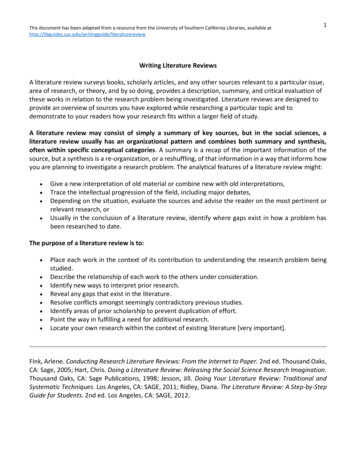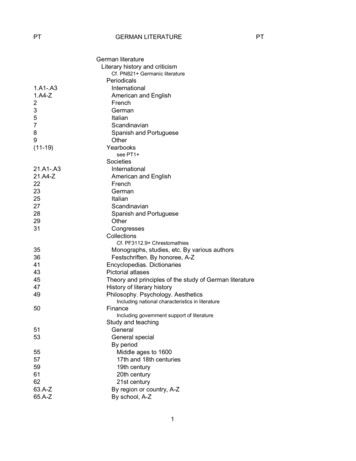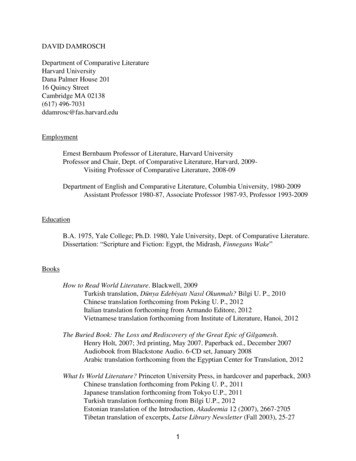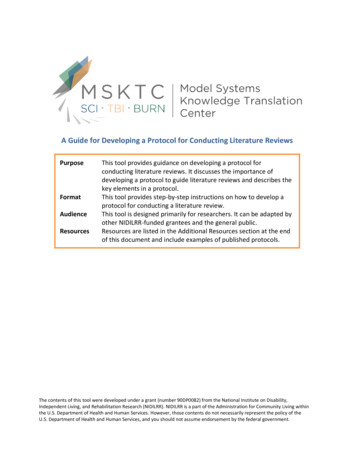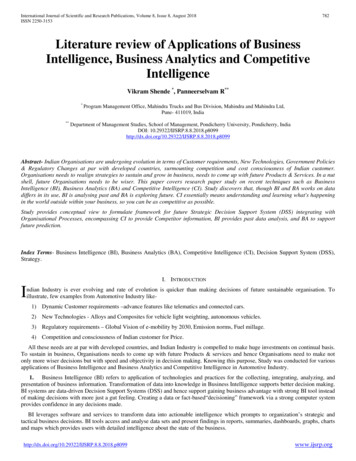
Transcription
International Journal of Scientific and Research Publications, Volume 8, Issue 8, August 2018ISSN 2250-3153782Literature review of Applications of BusinessIntelligence, Business Analytics and CompetitiveIntelligenceVikram Shende *, Panneerselvam R*****Program Management Office, Mahindra Trucks and Bus Division, Mahindra and Mahindra Ltd,Pune- 411019, IndiaDepartment of Management Studies, School of Management, Pondicherry University, Pondicherry, IndiaDOI: 29322/IJSRP.8.8.2018.p8099Abstract- Indian Organisations are undergoing evolution in terms of Customer requirements, New Technologies, Government Policies& Regulatory Changes at par with developed countries, surmounting competition and cost consciousness of Indian customer.Organisations needs to realign strategies to sustain and grow in business, needs to come up with future Products & Services. In a nutshell, future Organisations needs to be wiser. This paper covers research paper study on recent techniques such as BusinessIntelligence (BI), Business Analytics (BA) and Competitive Intelligence (CI). Study discovers that, though BI and BA works on datadiffers in its use, BI is analysing past and BA is exploring future. CI essentially means understanding and learning what's happeningin the world outside within your business, so you can be as competitive as possible.Study provides conceptual view to formulate framework for future Strategic Decision Support System (DSS) integrating withOrganisational Processes, encompassing CI to provide Competitor information, BI provides past data analysis, and BA to supportfuture prediction.Index Terms- Business Intelligence (BI), Business Analytics (BA), Competitive Intelligence (CI), Decision Support System (DSS),Strategy.I. INTRODUCTIONIndian Industry is ever evolving and rate of evolution is quicker than making decisions of future sustainable organisation. Toillustrate, few examples from Automotive Industry like1) Dynamic Customer requirements –advance features like telematics and connected cars.2) New Technologies - Alloys and Composites for vehicle light weighting, autonomous vehicles.3) Regulatory requirements – Global Vision of e-mobility by 2030, Emission norms, Fuel millage.4) Competition and consciousness of Indian customer for Price.All these needs are at par with developed countries, and Indian Industry is compelled to make huge investments on continual basis.To sustain in business, Organisations needs to come up with future Products & services and hence Organisations need to make notonly more wiser decisions but with speed and objectivity in decision making. Knowing this purpose, Study was conducted for variousapplications of Business Intelligence and Business Analytics and Competitive Intelligence in Automotive Industry.1. Business Intelligence (BI) refers to application of technologies and practices for the collecting, integrating, analyzing, andpresentation of business information. Transformation of data into knowledge in Business Intelligence supports better decision making.BI systems are data-driven Decision Support Systems (DSS) and hence support gaining business advantage with strong BI tool insteadof making decisions with more just a gut feeling. Creating a data or fact-based“decisioning” framework via a strong computer systemprovides confidence in any decisions made.BI leverages software and services to transform data into actionable intelligence which prompts to organization’s strategic andtactical business decisions. BI tools access and analyse data sets and present findings in reports, summaries, dashboards, graphs, chartsand maps which provides users with detailed intelligence about the state of the .p8099www.ijsrp.org
International Journal of Scientific and Research Publications, Volume 8, Issue 8, August 2018ISSN 2250-3153783There are five major components of BI – OLAP (On-line analytical processing): It refers to the way in which business users can slice and dice data using sophisticatedtools that allow for the navigation of dimensions such as time or hierarchies. Online Analytical Processing or OLAP providesmultidimensional, summarized views of business data and is used for reporting, analysis, modelling and planning for optimizing thebusiness. OLAP techniques and tools can be used to work with data warehouses or data marts designed for sophisticated enterpriseintelligence systems. These systems process queries required to discover trends and analyse critical factors. Reporting softwaregenerates aggregated views of data to keep the management informed about the state of their business. Other BI tools are used to storeand analyse data, such as data mining and data warehouses; decision support systems and forecasting; document warehouses anddocument management; knowledge management; mapping, information visualization, and dash boarding; management informationsystems, geographic information systems; Trend Analysis; Software as a Service (SaaS). Advanced Analytics: This is referred as data mining, forecasting or predictive analytics. It takes advantage of statisticalanalysis techniques to predict or provide certainty measures on facts. Corporate Performance Management (Portals, Scorecards, Dashboards): It usually provides a container for several pieces toplug into so that the aggregate tells a story. For example, a balanced scorecard that displays portlets for financial metrics combinedwith say organizational learning and growth metrics. Real time BI: It allows the real-time distribution of metrics through email, messaging systems and/or interactive displays. Data Warehouse and data marts: The data warehouse is the important component of business intelligence. Data warehousehelps the physical transmission of data to various enterprise records for integration, cleansing, aggregation and query tasks. Datawarehouse also contains the operations data used for which is used for tactical decision-making of a subject area. Though it containslive data, not snapshots but retains minimal history.Data marts contains historical operational data for trends and experiences which helps business experts to formulatestrategies. The need for data mart can be predicated based on a specific organizational requirement which calls for a certain groupingand configuration of select data. Organisation can have multiple data marts inside an enterprise. A data mart supports a businessfunction, business process or business unit in maintaining historical operational data. Data Sources: Data sources can contain various types of data such as operational, historical, external data for example datafrom market research regarding customer and competition or web-based information from the already existing data warehouseenvironment. Data from data sources can be relational databases or any other data structure that supports the line of businessapplications. They also can reside on many different platforms and can contain structured information, such as tables or spreadsheets,or unstructured information, such as plaintext files or pictures and other multimedia information.2. Analytics – It involves studying past historical data to identify potential trends, analyses of the effects of certain decisions orevents, or to evaluate the performance. Application of analytics mainly comprises to improve the business by gaining knowledgewhich can be used to make improvements or changes. Business Analytics (BA) relates to the exploration of historical data from many sources through statistical & quantitativeanalysis, data mining, predictive modelling and other techniques to identify trends and understand information that can drive businesschange, support sustained business practices.Business Analytics is the use of statistical tools & technologies to: Find patterns in data for analysis e.g. change in customer requirement Find out variability from the huge data points e.g. New Government Regulation Identify relationships within the data variables for further prediction e.g. drastic Loan Interest rate changes will changepurchase decision of Customer Provide insights as to what will happen next e.g. which of the Customers are leaving usThere are 6 major components in analytics Data Mining: Create models by discovering previously unknown trends and patterns in vast data e.g. detect insurance claimsfrauds, Retail Market basket analysis. There are various statistical techniques through which data mining is achieved. Classification is Regression Clustering Associations & Sequencing Models Text Mining: Discover and extract meaningful patterns and relationships from text collections e.g. understand sentiments ofCustomers on social media sites like Twitter, Face book, Blogs which are used to improve the Product or Customer service orunderstand how competitors are doing. Forecasting: Analyze & forecast processes that takes place over the time e.g. predict seasonal energy 099www.ijsrp.org
International Journal of Scientific and Research Publications, Volume 8, Issue 8, August 2018ISSN 2250-3153784 Predictive Analytics: Create, manage and deploy predictive scoring models e.g. Customer churn & retention, Credit Scoring,predicting failure in shop floor machinery Optimization: Use of simulations techniques to identify scenarios which will produce best results e.g. Sale price optimization,identifying optimal Inventory for maximum fulfilment & avoid stock outs Visualization: Enhanced exploratory data analysis & output of modelling results with highly interactive statistical graphics.3.Competitive Intelligence (CI)– Competitor intelligence is process that transforms disaggregated competitor information intorelevant, accurate and useable strategic knowledge about competitor positions, performance, capabilities and intentions. The purposeshould not be to obtain business or strategic plans but rather to gather continuously, in a systematic manner, a wide range ofinformation that, when collated and analysed, provides a fuller understanding of a competitor's structure, culture, behaviour,capabilities and weaknesses, and possible future plans.Competitor Intelligence is the purposeful and coordinated monitoring of your competitor(s), wherever and whoever they may be,within a specific marketplace. Competitors are those firms which are considered as rivals in business, and with whom you compete formarket share. It also has to do with determining what business rivals will do before they do it.' This is to gain early warning of theirplan in order to devise counter actions. It is the process of collecting and analyzing information about competitors’ strengths andweaknesses in a legal and ethical manner to enhance business decision-making. Competitive intelligence is different from corporate orindustrial espionage, which use illegal and unethical methods to gain an unfair competitive advantage.Though BI, BA, CI looks similar, but they are different –Table 1. Comparison of BI vs BABusiness IntelligenceBusiness AnalyticsIt reports on what happened in the past or what ishappening in now, in current time.It investigates why it happened & predict what mayhappen in future. Basic querying and reporting. OLAP cubes, slice and dice, drill-down Interactive display options – dashboards, Scorecards,Charts, graphs, alerts. Identifying relationships between key data variables Applying statistical and mathematical techniques. Reveal hidden patterns in dataIt Provides –It provides- Dashboards with “how are we doing” information Response to “what do we do next?” Standard reports and preset KPIs Alert mechanisms when something goes wrong Proactive and planned solutions for unknowncircumstances The ability to adapt and respond to changes andchallengesTable 2. Comparison of BI vs CIBusiness Intelligence (BI)Competitive Intelligence (CI)Business Intelligence is management of acompany’s internal data. This will help business tomake better decisions based on its own historicinformation and can therefore project possiblefuture trends.Competitive Intelligence is gathering and analyzing ofintelligence about the behavior of the competitors youdeal in, to make certain decisions based on markettrends.BI technologies provide historical, current, andpredictive views of business operationsCI enables business to monitor competitor behavior topinpoint their weak/strong points.Focus is internal business environment.Focus external business environment.A BI professional needs intensive database anddatabase design skills as well as technical IT skillsCI professional need skills in strategic thinking, shouldhave extensive analytical abilities and should ww.ijsrp.org
International Journal of Scientific and Research Publications, Volume 8, Issue 8, August 2018ISSN 2250-3153in BI and ETL icanalyticalII. LITERATURE REVIEWThe Literature review was conducted with relevance to study and application areas of BI, BA and CI in Automotive Industry andunderstand specificity.Around 600 research papers were studied and for content and relevance, 50 published journal papers selected for research paper study.Table 3. Paper SearchResearch SearchMore than 600Literature reviewBICIBA171716Table 4. BI Literature reviewS.N TitleResults / FindingsIndustry1 AnIntelligentDecision- Distributing used cars to various automobile- problem with multiple TransportatSupport System, IEEE, Zbignie M, variables - Marketing Head reviews the solution and possible changes ion&et.al (2005)required (less than1%)Logistics2 Progress in BI System research: A The topic that integrated research are- SCM, CRM, Data Mining, Agroliterature Review, IJBAS-IJENS - Data Warehouse, DSS, Performance Scorecard, KM, Business IndustryRina Fitriana (2011)Process Management, Artificial Intelligence, ERP, ExtractTransformation Loading, OLAP, Strategic Management.3 Integrating KM with BI Processes Integrated KM model with BI Model, can check how interaction of ITfor Enhanced Learning, Software BI with a KM model can support organizations to better manage theirEngineering and Its Applications - resources. The adopted model examines organizational efficiencyRizwan Shehzad, et.al (2013)improvement through enhanced learning.4 BI:concepts,components, The paper explores the concepts of BI, its components, benefits, Managemetechniques, JATIT - Jayanthi Ranjan factors influencing, technology requirements, designing and nt Studies(2009).implementing BI.5 A Knowledge-Based Approach for ystems ManagemeBI in Strategic Technologies: industry (Bio-MEMS). The model identifies the main actors, defines nt StudiesBio-Mems, AIS, Francisco J. Cantu, their roles and specifies the issues to be addressed. It handleset.al (2005)information about main products, market trends, companies, researchcenters, products, standardization.6 An Analysis on BI Maturity in Maturity model comprises of factors: organizational process, ManagemeMalaysian Organizations, IJISE -In technology, and outcome, spanning across 5 levels of maturity. Study nt StudiesLih Ong (2013)result indicate most of Malaysian Organizations are at low level ofmaturity.7 Business Intelligence, CAIS - Provides framework, importance of unstructured data & need to ManagemeSolomon Negash (2004)develop BI tools for acquisition, integration, cleanup, search, analysis nt Studiesand delivery.8 A BI Technique for forecasting The forecasting of sales data in automobile industry at Maruti, based AutomotivAutomobile Sales using Adaptive on monthly sales for past 5 years. Methods used Moving Average eIntelligent Systems, International and Exponential smoothing to forecast values as a input for ANFISJournal of Computer Applications - (Adaptive Neuro Fuzzy Inference System). Empirical resultsAlekh Dwivedi, et al. (2013)demonstrate that the ANFIS gives better results than ANN andLinear Regression models.9 Critical Success Factors for BI, CIS - Findings reveal that organizations which address the CSFs from a ITWilliam Yeoh, et al. (2009)business orientation approach will be more likely to achieve betterresults.10 The effect of BI Tools on Raising The main role of management accounting is to use available p8099www.ijsrp.org
International Journal of Scientific and Research Publications, Volume 8, Issue 8, August 2018ISSN 2250-3153786the Efficiency of Accounting, information in the best possible way to make decisions. The study nt StudiesIRMBR, Ziad Al-Zubi, et al. (2014) concludes that the decision process can be more effective, andManagement can save time and money by using BI.Table 4. BI Literature review (Contd.)S.N TitleResults / FindingsIndustry11 BI and CRM, Conference on IT Study concludes use of CRM systems and BI, provides a approach in SocialInterfaces, Aida Habul, et al. (2010) customers profiling, simpler detection of customers, measuring the Mediasuccess in satisfying its customers and create a comprehensive CRM.BI can detect incentives to increase sales, like faster conversion ofclients, less number of outgoing customers, increase sales to existingcustomers.12 A Classification for BI Agility A review of related work and the analysis of multiple case studies ITIndicators, AIS Electronic Library - leadtoadifferentiatedandmulti-levelHenning Baars, et al. (2013)agility classification for content, functional, and scale related BIagility concepts differentiated w.r.t architectural layer and reach.13 Business Intelligence Tools for Big BI allows easy interpretation of large volumes of data; identifying ManagemeData, Journal of Basic and AER- new insights & implementing effective strategies, helping nt StudiesLabhansh A, et al. (2016)organizations in long-term decision making and competitive market.14 Factors influencing BI Systems IT focuses CSF for BI implementation. Results suggested that Managemeimplementation success, AISEL, technical characteristic (i.e., relative advantage), organizational size, nt StudiesPACIS -Shin-Yuan Hung, et al. Top management support, and environment characteristic (consultant(2016)ability and training) were significant in affecting15 BI in Nutshell, IJIRCCE - Navita Paper explores the concepts of BI, data quality and issues, types of BI ManagemeKumari (2013)tools and delivery mechanisms and the key features of BI nt Studiesarchitecture.16 Application of BI-Agriculture “2020 This paper contains the approach to make Modern Agricultural more Agro“System to Improve Efficiency, effective by using BI. It contains fact and dimensional approach to IndustryJournal of Global Communication - support the decision-making capability of the farmer by makingGupta Anuraj (2016)simple reports.Table 5. CI Literature reviewS.N TitleResults / Findings1Planning and Strategy in Reforming Capacity development to anticipate, prevent and counter securityRomania's SRI, Counter Intelligence threatsNiculae Iancu, et al. (2012)2U.S Intelligence Community ReformPost-9/11: Strengthen U.S.'s Abilityto Fight Terrorism?, IRBernardyova, Alzbeta, et al. (2010)Assessing Uncertainty inIntelligence, Harvard School Jeffrey Friedman, et al. (2012)Measuring CI effectiveness: Insightsfrom the, Wiley Online Library Leigh Davison, et al. (Nov 2001)advertising industry345CI: A Key Business Success Factor,Management and Sustainability Cynthia A. Bulley, et al. (2013)6CI Adds Value: Five IntelligenceAttitudes, Elsevier - Daniel 8099IndustryGovt.Intelligence,SecurityReform of the U.S. intelligence community to counter terror attacks. Govt.Intelligence,SecurityProvides a analytic framework forManagemthinking about estimative intelligence in generalentStudiesDevelop CI Measurement Model (CIMM), provides concreteAdvertisimeasures for determining CI effectiveness. Additionally, the model ngaids in the calculation of the return on CI investment. CIMMclassifies CI output into two categories: short-term and long-termstrategic.Though Companies are aware of importance of CI yet to fully utilize Managemits potential. It is found that no coherent CI process is established but entrather a series of ‘ad-hoc’ measures are used. It implies the need toStudiesdevelop procedures for generating CI data.The authors report on the growing importance of competitiveManagemintelligence as a management practice in the majority of leadingentwww.ijsrp.org
International Journal of Scientific and Research Publications, Volume 8, Issue 8, August 2018ISSN 2250-3153et al. 099companies787Studieswww.ijsrp.org
International Journal of Scientific and Research Publications, Volume 8, Issue 8, August 2018ISSN 2250-3153788Table 5. CI Literature review (Contd.)S.N Title789101112131415161718Results / FindingsIndustrySocial media competitive analysisThe results reveal the value of social media competitive analysis and Foodsand text mining, Elsevier, Wu He, et the power of text mining as an effective technique to extract business Industryvalue from social media data. Recommendations are also provided toal. ( 2013)help companies develop their social media competitive analysisstrategy.Assessing the impact of using theThe findings indicate that research and use of Internet is significantly ManagemInternet for CIrelated to quality of CI information. However, the relationship entbetween internal use and quality of CI information is not significant. StudiesCI : concept, context and a case of its The paper analyzes the uniqueness of the Pharmaceutical Industry as Pharmaceapplication, Elsevier, Tsokanasopposed to other industries and reviews the presence of CI in this uticalindustryNikolaos, et al. (2012)IndustryCI collection and use by sales &Using social identity theory as a conceptual background, this paperManagemservice representatives, Springerreports two studies which investigate how organizationalentLink, Adam Rapp, et al. (2014)identification and role conflict impact the collection and use ofStudiesindividual competitive intelligence & how this impacts performance.Generating CI Organizations,It describes three interdependent phases of CIManagemSpringer Link, Bernard J, et al.organizing for CI, searching for information, and sense-making. Itent(2002)also identifies core components of CI generation process,Studieshighlighting its iterative nature, and identifying for its success.Self-Organizing Maps forSelf-Organizing Map (SOM) technique used to identify keyCellCompetitive Technicalcompetitors and determine key technical attributes of electronicPhoneIntelligence Analysis, CIS, Lu An, et products. The cell phone SOM display was projected into spaceIndustryal. (2012)constructed by key technical attributes and SWOT of competitorswere explored.Connecting strategy and CI toGenerating intelligence of value to strategy makers.Managemproduce strategy inputs, StrategyentLeadership Journal - Liam FaheyStudies(2007)ManagemA Process‐Oriented View of CI and Competitive strategy and the CI administration - influences thesubsequent analysis and extent to which information is disseminated. entits Impact on OrganizationalStudiesPerformance, CI and Management - When CI is located in the marketing area, there is greaterdissemination within marketing, relative to other functional areas inKersi D. Antia, et al. (2007)the firm.The effect of infrastructure, culture, It shows effects of corporate culture, organizational structure andManagemorganizational, structure and CI inimpact of information technology on CI in Organizations.entOrganization, Journal on AcademicStudiesof OB and HRM - Maryam SadatHashemi (2016)The Usefulness of CI & Relationship CI framework design suitable to meet the needs of the key strategic Managemto the Strategy of the Firm, AMSmarketing decision makers.entConf.-Donna Cartwright, et al.Studies(2014)CI in social media Twitter: iPhone 6 The analysis showed that social media data contain CI. The volume Socialvs. Galaxy S5, Emerald, Yoosinof tweets revealed a significant gap between the market leader andMediaKim, et al. (2016)follower; the purchase intention data also reflected this gap, but to aless extent.Planning and Strategy in Reforming Capacity development to anticipate, prevent and counter securityGovt.Romania's SRI, Journal of CIthreatsNiculae Iancu, 099www.ijsrp.org
International Journal of Scientific and Research Publications, Volume 8, Issue 8, August 2018ISSN .p8099789www.ijsrp.org
International Journal of Scientific and Research Publications, Volume 8, Issue 8, August 2018ISSN 2250-3153790Table 6. BA Literature reviewS.N Title1 Integrating BA into strategic planningfor better performance, BusinessStrategy-Tobias Klatt, et al. (2011)2Results / FindingsThis paper combines insights on the best usage of businessanalytics from the perspective of strategic planning experts, withrecommendations for the integration of business analytics into theperformance management.Extracting value from the huge amounts of data available in theSCM areaThe impact of big data and BA onSCM, Transport & SCM Journal Hans W. Ittmann (2015)3 Big data analytics in logistics &SCM Paper proposes framework for Logistics Analytics within SCM, Elsevier, IJPE - Gang Wang, et al. ( naming as SCA, based on four capability levels- functional,2016)process-based, collaborative agile SCA, and sustainable SCA.4 Innovations in Business Forecasting: Proactively predicts demand instead of replenishing requirementsPredictive Analytics, Business- access data, analyses & provide insights to make decisions toForecasting - Charles W Chase (2014) put you ahead of demand curve. Using DSR information fordemand sensing to identify major market signals and using themto shape future demand.5 Barriers to the Adoption of Big Data Paper identifies barriers for Automotive Industry –Analytics in the Automotive Sector, (1) sufficient and skilled resources, (2) the collaboration ofAISEL, AMCIS - Christian Dremel different business departments, supported by (3) appropriate(2017)organizational structures, (4) data-driven culture, (5) definedbusiness value, (6) access to relevant data pools.6 Performance Management Analytics Study compares several algorithms: Random Forest, Partial LeastFor Automotive Industry: Study,Squares, M5, Artificial Neural Network, Support VectorUniversity of Porto - Joao Carlos Dias Machines and K Nearest Neighbors were tested. ThirteenCorreia Pinto (2016)different sets of predictive variables were tested.7 BA in SCM, Lodz University- Anna SCM and BI solutions with their capacity to integrate with otherWalaszczyk, et al. (2017)systems to perform product segmentation and presents results.8 Integrating BA withBA is associated with affective decision making and betterperformance management, IJSER performance management. Proper integration of performanceSultan Gashgari (2016)management with business analytics provides basis for affectiveand rational decision making for the management.9 IOP Conference - Taufik DjatnaPaper reveals the feature selection gain ratio & k-NN outperforms(2017)forecasting models, implying the proposed approach is apromising alternative to stock market tendency of warehousereceipt document exploration with accuracy level rate - 95.03%.10 Role of BA in ManagementInclusion of Business Analytics in Management StudiesEducation, Eureka - Surabhi S (2017)11 Customer Attrition Analytics inThe company realized that its trust accounts were getting closedBanking, BA and Intelligence - Mihir after a period of seven to twelve years. Model was built inDash, et al. (2017)analytics to predict customer churn and come up with strategies toretain customers.12 Management challenges in creating Presents a Delphi study on the challenges of big data analytics.value from BA, Elsevier, RichardProvides insight into analytics as a complex socio-technicalVidgen, et al. (2017)entanglement and need for data driven management.13 How do top & bottom performingIt recommends BA, data-driven environment. Also providescompany differ using BA? Emerald, management insights into the effective use of BA for improvingGuangming Cao, et al. (2017)organizational performance.14 eMobility market platforms –The number of urban travel modes has increased significantly andApplications of BA, Springer,now includes services such as car sharing, ridesharing and bikeChristoph Willing, et al. (2017)sharing. This paper, describes the business model of MMPs.15 Applications of BA in healthcare,This article explores Healthcare applications, barriers and ways toElsevier, Business Horizons - Michael goals of the modern healthcare system: high-quality, responsive,J. Ward, et al. (2014)affordable, and efficient arewww.ijsrp.org
International Journal of Scientific and Research Publications, Volume 8, Issue 8, August 2018ISSN 2250-3153791Table 6. BA Literature review (Contd.)S.N Title16 Perception, reality, adoption of BA:Evidence from North Americanprofessional sport Orgs, Elsevier,Omega -Michael Troilo, et al. (2016)17 Gaining Business Value through BDA:A Case Study of the Energy Sector,AISEL, Decision Analytics - AMCIS Mariya Sodenkamp, et al. (2015)Results / FindingsProfessional sports teams have made extensive use of analyticsto improve their on-field performance. However, it is not asapparent that these same organizations use analytics to improveperformance on the “business” side.Using datasets containing annual electricity consumption ofprivate
Table 2. Comparison of BI vs CI Business Intelligence (BI) Competitive Intelligence (CI) Business Intelligence is management of a company's internal data. This will help business to make better decisions based on its own historic information and can therefore project possible future trends. Competitive Intelligence is gathering and analyzing of


